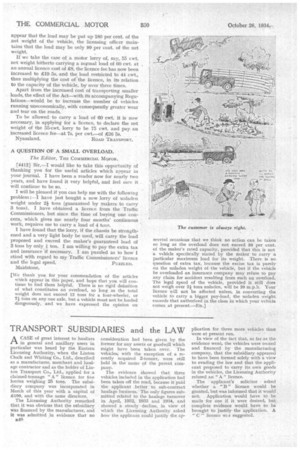TRANSPORT SUBSIDIARIES and the LAW
Page 54

If you've noticed an error in this article please click here to report it so we can fix it.
ACASE of great interest to hauliers in general and ancillary users in particular was heard by the Eastern Licensing Authority, when the Linton Chalk and Whiting Co., Ltd., described as a manufacturer, merchant and haulage contractor and as the holder of Linton Transport Co., Ltd., applied for a claimed-tonnage " A" licence for five lorries weighing 25 tons. The subsidiary company was incorporated in March of this year with a capital of 1100, and with the same directors.
The Licensing Authority remarked that it was obvious that the subsidiary Was financed by the manufacturer, and it was admitted in evidence that no consideration had been given by the former for any assets or goodwill which might have been taken over. The vehicles; with the exception of a recently acquired 2-tonner, were still held in the name of the parent company. The evidence Showed that three vehicles included in the application had been taken off the road, because it paid the applicant better to sub-contract haulage business. The only figures submitted related to the haulage turnover in April, 1932, 1933 and 1934, and showed a steady decline, in view of which the Licensing Authority asked how the applicant could justify the ap
plication for three more vehicles than were at present run.
In view of the fact that, so far as the evidence went, the vehicles were owned and financed by the manufacturing company, that the subsidiary appeared to have been formed solely with a view to evading the law and that the applicant proposed to carry its own goods in the vehicles, the Licensing Authority refused an " A " licence.
The applicant's solicitor asked whether a "B" licence would be granted, but was informed that it would not. Application would have to be made for one if it were desired, but complete evidence would have to be brought to justify the application. A "C " licence W2 s suggested.




























































































